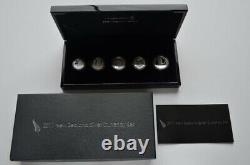
- Index
- Brand
- Cfk (6)
- Dc Comics (11)
- Dc Justice League (10)
- Disney (24)
- Harry Potter (3)
- Justice League (3)
- Marvel (5)
- Mayer Mint Gmbh (9)
- Methven (3)
- Millennium Falcon (3)
- New Zealand Mint (63)
- New Zealand Post (11)
- Niue (3)
- Private Mint (5)
- Pro Wheels (7)
- Royal Dutch Mint (6)
- Star Trek (5)
- Star Wars (6)
- Sunshine Minting (3)
- Windermere (2)
- Other (2872)
- Certification
- Anacs (15)
- Certified (10)
- Certified By Mint (5)
- Cgc (24)
- Coa (6)
- Mint Certification (9)
- Mint Certified (21)
- New Zealand Mint (45)
- Ngc (693)
- Ngc & Mac (74)
- Nz Mint (9)
- Nz Post (13)
- Nzmint (72)
- Nzpost (173)
- Pcgs (110)
- Pcgs & Mac (10)
- Reservebank (5)
- Silver Proof (19)
- Uncertified (1484)
- Yes (9)
- Other (254)
- Country
- Fineness
- Metal
- Year
2011 New Zealand Silver Currency Set (#901 of 1200) New Price





The five iconic designs in this silver proof coins set are. The ten cent coin features a Maori carved head or'koruru' with Maori rafter patterns.
Koruru are usually mounted on the gables of wharenui (meeting houses) and are referred to as'The guardians of the house'. The Maori carving shown on the 20 cent coin is a reproduction of a specific carving of an 18th century Maori warrior leader called Pukaki, who was a rangatira (chief) of the Ngati Whakaue iwi of Te Arawa in the Rotorua district. The carving was made in 1836 and today it can be viewed in the entrance to the Rotorua District Council building. The edging of this coin is distinctive and known as'Spanish flower'.
New Zealand fifty cents The design on the 50 cent coin shows the Endeavour sailing south with Mount Taranaki (Egmont) in the distance. The Endeavour was a British Royal Navy research vessel commanded by Lieutenant James Cook on his first voyage of discovery, to Australia and New Zealand from 1769 to 1771.
This small, flightless bird has been in New Zealand for more than 60 million years, and is largely nocturnal. It has become so much a part of New Zealand's national identity that New Zealanders overseas (and at home) colloquially refer to themselves as'Kiwis'. It is one of New Zealand's rarest birds and is held in particularly high regard in Maori mythology. Kotuku have figured prominently in Maori legend as exemplars of rarity, grace and beauty, and as inhabitants of the spirit world. Milled with a channel with ten raised beads. Portrait of Her Majesty Queen Elizabeth II by Ian Rank-Broadley, Englan. The kotuku (white heron) flying right. Eight alternate segments, four milled and four plain. The kiwi, bringing to reality the colloquial term'Kiwi Dollar. The Endeavour sailing south, with Mount Taranaki (Egmont) in the distance. Maori carved head or koruru.
